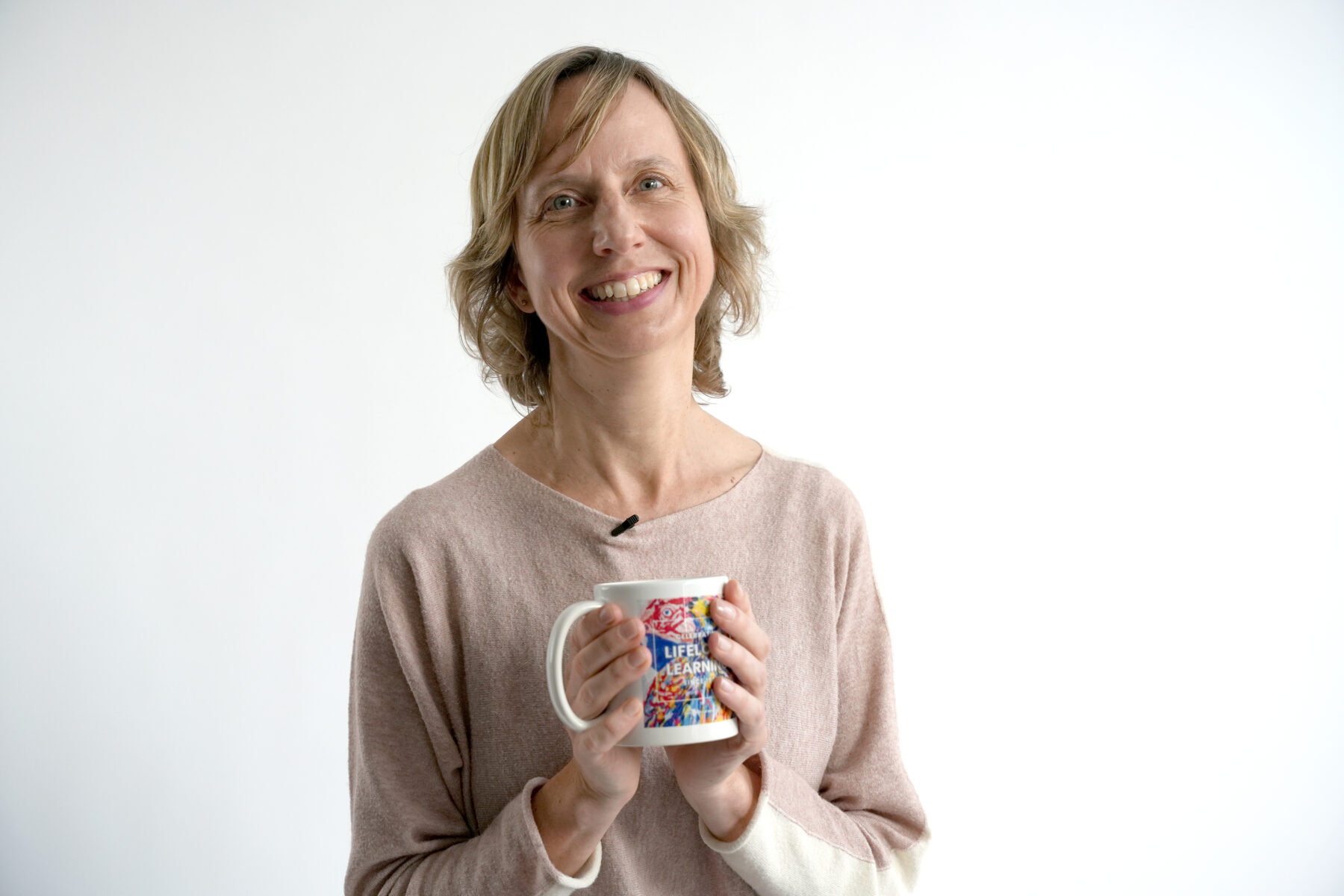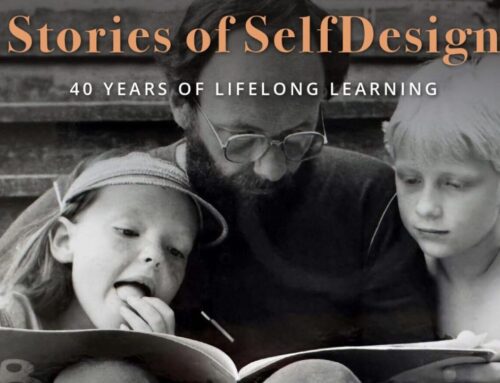SelfDesign educator Darcy Kaltio tells a story of how nurturing and supportive the SelfDesign approach to learning is. In about 2006, a child and mother visited the Wondertree Learning Centre in Vancouver, where Darcy was working, to see if it would be a good fit for them.
 Wondertree is SelfDesign’s predecessor. From 1983 to 2009, the Wondertree Learning Centre brought learners aged 5–15 together to learn in person in collaborative groups of up to 15. Each group was supported at the centre by learning consultants, mentors and parents.
Wondertree is SelfDesign’s predecessor. From 1983 to 2009, the Wondertree Learning Centre brought learners aged 5–15 together to learn in person in collaborative groups of up to 15. Each group was supported at the centre by learning consultants, mentors and parents.
Darcy says, “This young girl came and walked around. Then she looked at me, and she said, ‘There are rainbows between the hearts of everybody here.’”
The child’s perceptiveness took Darcy a bit aback. “I was like, ‘You know, I feel that, but I never would have known how to say it.’ This seven-year-old captured that heart connection that Wondertree and SelfDesign cultivated. She felt it and saw it and described it.”
That connection is what has attracted Darcy to SelfDesign in its various forms over the years.
“The values of SelfDesign are so aligned with my own values,” she says. “I think through all of my work, I had these basic beliefs around learners’ rights to be self-directed, with the family being essential and most important, around the relationship being everything, and about communication being key. And that you can make mistakes and change your mind, and, you know, that’s fine — like, that’s good. And being able to have that everywhere in my life and, of course, in my work has been a real privilege.”
First encounters
Darcy applied to become a learning consultant with Vancouver’s Wondertree Learning Centre in January 2005. It was not her first exposure to one of SelfDesign founder Brent Cameron’s unique educational programs.
In the mid-1990s, she had heard Brent and his colleague Michael Maser talking about Virtual High on CBC Radio.
Brent and Michael created and operated Virtual High in an old house in Vancouver from 1993 to 1997. It was intended to be an online, remote-learning program for teens at risk of not finishing school. However, it quickly transformed into a tight-knit, in-person learning community of about 35 youth and their educators and mentors.
“The whole idea of this learner-led community of kids they were proposing really spoke to me,” Darcy says. Already finished grade 12, she missed out on being able to join Virtual High as a learner by a couple of years, but the seed was planted. Darcy’s dream career became to work in alternative education.
She obtained her education degree from the University of Victoria and spent several years teaching English as a second language, gaining classroom experience, travelling and having other adventures.
In 2005, she decided she was ready to pursue her dream of working in an alternative school.
“Brent Cameron’ was the first name I thought of,” Darcy says. She called the Wondertree Learning Centre in Vancouver. Brent picked up the phone. “He said, ‘I was just about to put an ad in the newspaper. We’re hiring.’ Then he said, ‘I won’t place the ad. Meet me for lunch tomorrow. We’ll talk.’”
They met. They talked. He suggested she volunteer for the semester because “‘the parents and the learners ultimately decide if they want to hire you.’”
Darcy says, “They never did put that ad in the paper that year. I started volunteering right away, and the community there decided to hire me as the learning consultant the following September. It was really lucky timing.”
Darcy’s SelfDesign working journey
Darcy has undertaken numerous roles with Wondertree and SelfDesign® Learning Community since 2005. In addition to working at the Wondertree Learning Centre in Vancouver for two years, in 2007–2008, she supported a group of parents in setting up the new Wynndel Wondertree learning centre in Creston, and in 2008-2009, helped a colleague run another learning centre on Vancouver Island.
In 2009, when Brent and his colleagues on the leadership team decided to close the Wondertree Learning Centres and focus on SelfDesign Learning Community, Darcy applied to be a learning consultant with the province-wide online school.
“From that point on, I’ve been working online with SelfDesign Learning Community in different capacities,” she says. She started working with learners in kindergarten to grade nine, then with learners up to grade 12. She worked with Family Services for a few years. She did administrative support. She was part of a small group of educators who worked with River Meyer, SelfDesign’s Director of Organizational Learning & Culture until early 2024, to define and clarify SelfDesign’s philosophy, models and approach. She also is one of the first group of SelfDesign educators who got their graduate degrees through the SelfDesign Graduate Institute.
When the pandemic arrived, Darcy moved into a professional support provider role. She now supports SelfDesign learners who have diagnosed learning challenges and need extra support in their learning.
Darcy’s SelfDesign learning journey
“It was such a transformative time — like, really remarkable,” Darcy says of her first years with Wondertree.
She’s not the only educator who has found working with SelfDesign changed their work and their lives.
For example, Verena Gibbs, who joined Wondertree in 2002 and was the Wondertree vice principal while Darcy was with the program, says of her own experience, “It transformed the way I approach learning and learning systems. The gifts it gave me regarding my own personal awareness and personal mastery were incredible. It was, at times, infuriating and frustrating and chaotic and messy, and it was also beautiful and heartfelt and community-driven.”
Darcy says, “I learned so much during those first years with Wondertree. It was radical for me to see it in action. We were adults communicating with children in a completely respectful way, with so much vulnerability and humility, and also leadership and boundaries. I had so much to learn, and making mistakes together and problem-solving together, like, ‘We don’t really know how to handle this, so let’s talk about it as a community.’ It was just really amazing to see it in practice and in the lived experience and, then, to experience the depth of care and heart when it was my turn.”
Her turn came in August after her first year as a learning consultant. That is when she found out that Wondertree learners and parents decided not only whom to hire to be learning consultants but also whom to let go.
Darcy was at home with her parents when Brent called. “He said, ‘There’s a bit of an issue.’ I was like, ‘Oh?’ And he said, ‘The parents might not want you to be a learning consultant anymore.’ Up until then, I hadn’t heard anything. I thought everything was fine. He said, ‘They’re just saying that you’re a little bit closed off in the mornings, and maybe not that available to them.’ And I was, like, ‘Oh, yeah, that sounds like me.’”
She told Brent that she had spent her first year at Wondertree dealing with anxiety: there was so much to do and so much to learn.
“And he said, ‘Don’t worry, I know you’re great, and I’m talking with the parents. I just wanted to let you know that this is what the parents are talking about in the background, and they finally shared it with me.’ I was totally terrified. I was like, ‘Uh-oh, this is it.’”
A week or so later, she met with Brent and a few other learning consultants. Sitting on the lawn outside the learning centre at Jericho Park, they asked Darcy about her experience and her life and talked about how to handle the situation.
“It was just this beautiful opportunity for growth and for really seeing myself in there,” Darcy says. “I realized I could do things — like, have just one cup of coffee in the morning, not two, or arrive an hour early, instead of 15 minutes early. There were all these really practical things that I could do to make a difference.”
She says having that experience of that much care and investment in her changed her.
“It was just so, so beautiful. I’d never had that in my life before. And it really showed me what’s possible. It’s not about being perfect because in a caring community, you can just be vulnerable with your weaknesses and get support.”
Since then and in her work now as a support provider for learners with diagnosed learning difficulties, she tries to apply the same relationship-based approach to her work with learners and families — and to her life outside of work.
“I feel that it permeates everything,” she says. “I sometimes forget it in my real life, but I try to remember.”
Being part of a nurturing and supportive community that, in turn, encourages nurturing and supportive relationships feeds into Darcy’s passion for the SelfDesign approach.
“Work really is so much of my passion. Work doesn’t feel like work to me. It just feels like self expression.”
Meet other members of SelfDesign’s community, past and present
Meet SelfDesign learners, past and present







